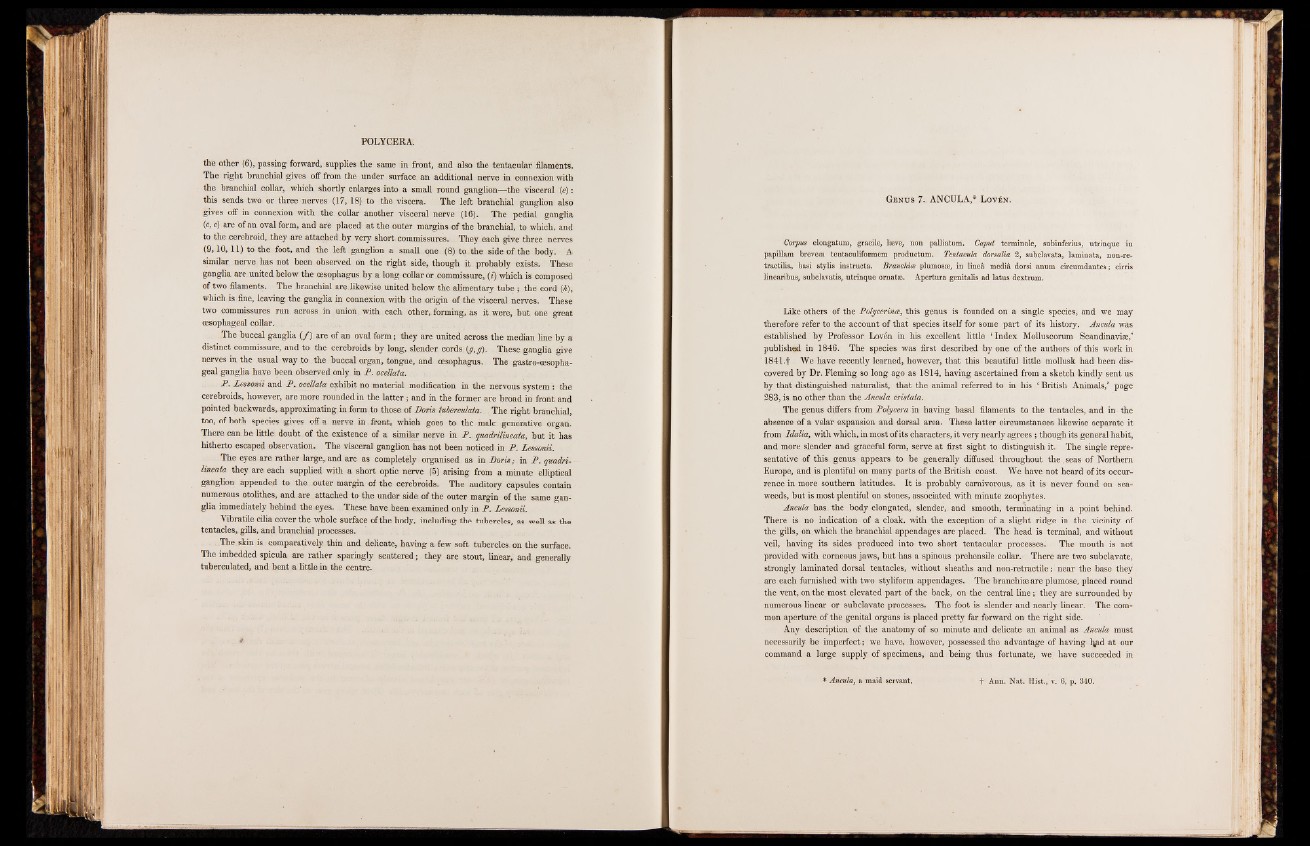
the other (6), passing forward, supplies the same in front, and also the tentacular filaments.
The right branchial gives off from the under surface, an additional nerve in connexion with
the branchial collar, which shortly enlarges into a small round ganglion—the visceral (e)s
this sends two or three nerves (17, 18) to the viscera. The left branchial ganglion also
gives off in connexion with the collar another visceral nerve (16). The pedial ganglia
(c, c) are of an oval form, and are placed at the outer margins of the branchial, to which, and
to the cerebroid, they are attached .by very short commissures.. They each give three nerves
(9,10,11) to the foot, and the left ganglion a small one (8> to the side of the body. A.
similar nerve has not been observed on the right side, though it probably exists. These
ganglia are united below the oesophagus by a long collar or .commissure, (i) which is composed
of two filaments. The branchial are,likewise united below the alimentary tube s the cord (fi),
which is fine, leaving the ganglia in connexion with the origin of the visceral nerves. These
two commissures run across in union with each other, forming, as it were, but one great
oesophageal collar.
The buccal ganglia ,(/).are of an oval form; they are united across the median line by a
distinct commissure, and to the cerebroids by long, slender cords, [g, g). These, ganglia give
nerves in the usual way to the buccal organ, tongue, and oesophagus. The gastro-cesopha-
geal ganglia have been, observed only in P. ocellata.
P- Leasonii and P , ocellata exhibit no material modification in the nervous system: the
cerebroids, however, are more rounded in the latter; and in the former are broad in front and
pointed backwards, approximating in form,to those of Doris tubereulata. The right branchial,
too, of both species gives off a nerve in front, which goes to the male generative organ.
There can.be little: doubt of the existence of a similar nerve in P .. (juadrilincata, but it has
hitherto escaped observation. The visceral ganglion has not been noticed in P. Lrnonii.
The eyes are rather large, and are as completely organised as in Doris; in P. quaclri-
lineata they are each supplied with a short optic nerve (6) arising from a minute elliptical
ganglion appended to the . outer margin of the cerebroids. The auditory capsules contain
numerous otolithes, and are attached to the under side of the outer margin of the same ganglia
immediately behind the.eyes, . These have.been examined only i n P. lessonii.
Vibratile cilia cover the whole surface of the body, including the tubercles, as well as the
tentacles, gills, and branchial processes.
The skin is comparatively thin and delicate, having a few soft tubercles on the surface.
The imbedded spicula are rather sparingly scattered; they are stout, linear, and generally
tuberculated, and bent a little in the centre.
Gbnds 7. ANCULA,* LovfiN.
Corpus elongatum, gracile, laeve, non palliatum. Caput terminale, subinferius, utrinque in
papillam brevem tentaculifownem productum. Tentacula dorsalia 2, subclavata, laminata, non-re-
tractilia, basi stylis instructa. Branchics plumosse, in lineä mediä dorsi ännm circumdantes; cirris
linearibus, subclavatis, utrinque ornatse. Apertura genitalis ad latus dextrum.
Like others of the Polycerina, this genus is founded on a single species, and we may
therefore refer to the account of that species itself for some part of its history. Ancula was
established by Professor Loven in his excellent little ‘ Index Molluscorum Scandinaviae,’
published in 1846. The species was first described by one of the authors of this work in
1841.f We have recently learned, however, that this beautiful little mollusk had been discovered
by Dr. Fleming so long ago as 1814, having ascertained from a sketch kindly sent us
by that distinguished naturalist, that the animal referred to in his ‘ British Animals/ page
283, is no other than the Ancula cristata.
The genus differs from Polycera in having basal filaments to the tentacles, and in the
absence of a velar expansion and dorsal area. These latter circumstances likewise separate it
from Idalia, with which, in most of its characters, it very nearly agrees ; though its general habit,
and more slender and graceful form, serve at first sight to distinguish it. The single representative
of this genus appears to be generally diffused throughout the .seas of Northern
Europe, and is plentiful on many parts of the British coast. We have not heard of its occurrence
in more southern latitudes. It is probably carnivorous, as it is never found on seaweeds,
but is most plentiful on stones, associated with minute zoophytes.
Ancula has the body elongated, slender, and smooth, terminating in a point behind.
There is no indication of a cloak, with the exception of a slight ridge in the vicinity of
the gills, on. which the branchial appendages are placed. The head is terminal, and without
veil, having its sides produced into two short tentacular processes. The mouth is not
provided with corneous jaws, but has a spinous prehensile collar.- There are two subclavate,
strongly laminated dorsal tentacles, without sheaths and non-retractile; near the base they
are each furnished with two styliform appendages. The branchiae are plumose, placed round
the vent, on the most elevated part of the back, on the central line; they are surrounded by
numerous linear or subclavate processes. The foot is slender and nearly linear. The common
aperture of the genital organs is placed pretty far forward on the right side.
Any description of the anatomy of so minute and delicate an animal as Ancula must
necessarily be imperfect; we have, however, possessed the advantage of having fyid at our
command a large supply of specimens, and being thus fortunate, we; have succeeded in
* Ancula, a maid servant. t ' Ann. Nat. Hist., v. 6, p. 340.